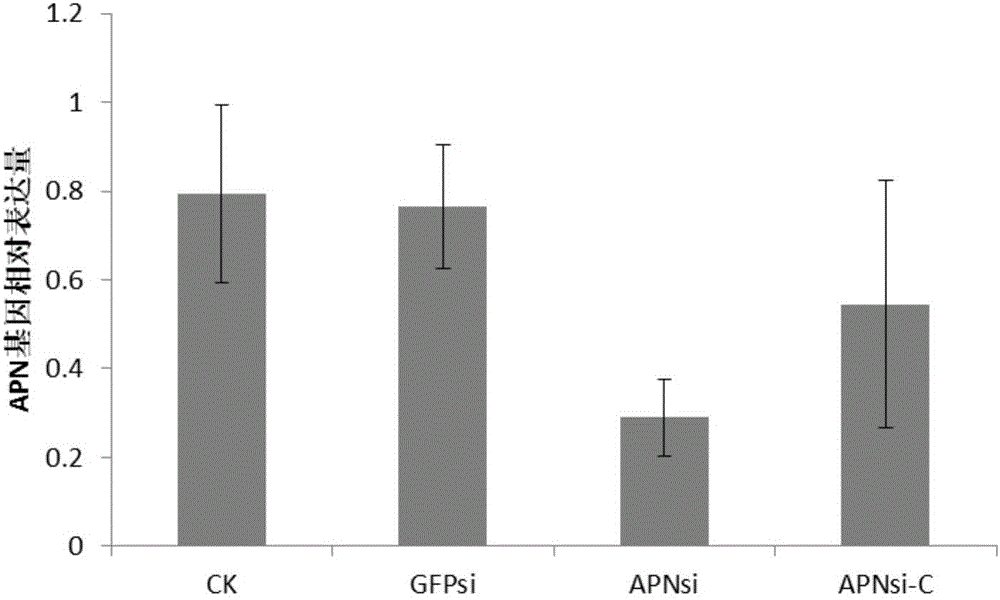Method for improving RNA interfering efficiency of mandibulate insects
An RNA interference and chewing technology, applied in the biological field, can solve the problems of slow action, high insect mortality, and low efficiency
Inactive Publication Date: 2016-07-20
INST OF PLANT PROTECTION CHINESE ACAD OF AGRI SCI
View PDF1 Cites 4 Cited by
- Summary
- Abstract
- Description
- Claims
- Application Information
AI Technical Summary
Problems solved by technology
The more commonly used methods of introducing siRNA into insects are mainly injection and feeding methods. The injection method requires special equipment, and the mechanical damage of the injection itself will cause a high mortality rate of the insects; the feeding method is relatively simple, but It has the characteristics of slow action and low efficiency
Method used
the structure of the environmentally friendly knitted fabric provided by the present invention; figure 2 Flow chart of the yarn wrapping machine for environmentally friendly knitted fabrics and storage devices; image 3 Is the parameter map of the yarn covering machine
View moreImage
Smart Image Click on the blue labels to locate them in the text.
Smart ImageViewing Examples
Examples
Experimental program
Comparison scheme
Effect test
Embodiment 1
[0020] The impact of embodiment 1 RNA interference on APN gene of cotton bollworm
the structure of the environmentally friendly knitted fabric provided by the present invention; figure 2 Flow chart of the yarn wrapping machine for environmentally friendly knitted fabrics and storage devices; image 3 Is the parameter map of the yarn covering machine
Login to View More PUM
 Login to View More
Login to View More Abstract
The invention provides a method for improving RNA interfering efficiency of mandibulate insects, comprising: 1), preparing target gene specific siRNA into a solution of certain concentration using water free of RNA enzyme; 2), processing artificial feed into discs 3-5 mm in thickness and 1-2 cm in diameter, and placing the discs in a 24-pore plate; 3), adding the solution of step 1) to the discs of step 2) so that the solution is absorbed by the feed completely; 4), placing newly hatched larvae of mandibulate insects into the 24-pore plate with the feed discs of step 3), feeding for a period of time, and detecting target gene expression of the insects. By modifying the method of feeding insect siRNA, the method for improving RNA interfering efficiency of mandibulate insects is established; the method is efficient and simple and highly operable, usage of siRNA is saved, interfering effect is significant, and technical support is provided for studying the functionality of genes of mandibulate insects.
Description
technical field [0001] The invention relates to the field of biotechnology, in particular to a method for improving RNA interference efficiency of chewing mouthpart insects. Background technique [0002] Small molecular weight RNA (smallRNA) is a class of non-coding RNA molecules with a length of about 20-30 nucleotides (nt). Since it was first discovered in nematodes in 1995, it has attracted more and more attention from relevant scientists because of its special biological functions. According to the synthetic route, small molecular weight RNA can be divided into two types: small molecular weight interfering RNA (small interfering RNA, siRNA) and microRNA (microRNA, miRNA). When some small molecular weight endogenous or exogenous double-stranded RNA (double-strandedRNA, dsRNA) molecules are introduced into the host cell, they will induce specific degradation of the homologous endogenous mRNA, thereby efficiently and specifically It blocks the expression activity of homol...
Claims
the structure of the environmentally friendly knitted fabric provided by the present invention; figure 2 Flow chart of the yarn wrapping machine for environmentally friendly knitted fabrics and storage devices; image 3 Is the parameter map of the yarn covering machine
Login to View More Application Information
Patent Timeline
 Login to View More
Login to View More IPC IPC(8): C12N15/87A01K67/033
CPCA01K67/0339A01K2207/05A01K2217/058A01K2227/706C12N9/485C12N15/87
Inventor 王冰洁袁向东梁革梅张万娜魏纪珍
Owner INST OF PLANT PROTECTION CHINESE ACAD OF AGRI SCI
Features
- R&D
- Intellectual Property
- Life Sciences
- Materials
- Tech Scout
Why Patsnap Eureka
- Unparalleled Data Quality
- Higher Quality Content
- 60% Fewer Hallucinations
Social media
Patsnap Eureka Blog
Learn More Browse by: Latest US Patents, China's latest patents, Technical Efficacy Thesaurus, Application Domain, Technology Topic, Popular Technical Reports.
© 2025 PatSnap. All rights reserved.Legal|Privacy policy|Modern Slavery Act Transparency Statement|Sitemap|About US| Contact US: help@patsnap.com



